Properties and Microstructure Distribution of High-Performance Thermal Insulation Concrete
Abstract
1. Introduction and Background
2. Experimental Program and Methods
2.1. Materials and Mixture Design
2.2. Experimental Procedures
Material Preparation
2.3. Sampling
2.4. Testing
2.4.1. Mechanical Properties Testing
2.4.2. Thermal Conductivity Testing
2.4.3. Microstructural Analysis
3. Results and Discussions
3.1. Compressive Strength
3.2. Flexural Strength
3.3. Thermal Conductivity
3.4. X-ray µCT Analysis
3.5. Comparison of Proposed Concrete Mixture versus Published Results
4. Conclusions
Author Contributions
Funding
Acknowledgments
Conflicts of Interest
References
- Abergel, T.; Dean, B.; Dulac, J. Towards A Zero-Emission, Efficient, and Resilient Buildings and Construction Sector: Global Status Report 2017; UN Environment and International Energy Agency: Paris, France, 2017. [Google Scholar]
- Nejat, P.; Jomehzadeh, F.; Taheri, M.M.; Gohari, M.; Majid, M.Z.A. A global review of energy consumption, CO2 emissions and policy in the residential sector (with an overview of the top ten CO2 emitting countries). Renew. Sustain. Energy Rev. 2015, 43, 843–862. [Google Scholar] [CrossRef]
- International Energy Agency. Transition to Sustainable Buildings Strategies Opportunities to 2050; IEA: Paris, France, 2013. [Google Scholar]
- Ma, J.-J.; Ma, J.-J.; Du, G.; Zhang, Z.-K.; Wang, P.-X.; Xie, B.-X. Life cycle analysis of energy consumption and CO2 emissions from a typical large office building in Tianjin, China. Build. Environ. 2017, 117, 36–48. [Google Scholar] [CrossRef]
- Mohammad, M.; Isaifan, R.J.; Weldu, Y.W.; Rahman, M.A.; Al-Ghamdi, S.G. Progress on carbon dioxide capture, storage and utilisation. Int. J. Glob. Warm. 2020, 20, 124–144. [Google Scholar] [CrossRef]
- Pachauri, R.K.; Allen, M.R.; Barros, V.R.; Broome, J.; Cramer, W.; Christ, R.; Church, J.A.; Clarke, L.; Dahe, Q.; Dasgupta, P.; et al. Climate Change 2014: Synthesis Report. Contribution of Working Groups I, II and III to the Fifth Assessment Report of the Intergovernmental Panel on Climate Change; IPCC: Geneva, Switzerland, 2014. [Google Scholar]
- Hughes, B.R.; Calautit, J.K.; Ghani, S.A. The development of commercial wind towers for natural ventilation: A review. Appl. Energy 2012, 92, 606–627. [Google Scholar] [CrossRef]
- Peterková, J.; Zach, J.; Sedlmajer, M. Development of advanced plasters for insulation and renovation of building constructions with regard to their hygrothermal behaviour. Cem. Concr. Compos. 2018, 92, 47–55. [Google Scholar] [CrossRef]
- Clinch, J.P.; Healy, J.D. Domestic energy efficiency in Ireland: Correcting market failure. Energy Policy 2000, 28, 1–8. [Google Scholar] [CrossRef]
- Ferreira, M.A.; Almeida, M.G.; Rodrigues, A.; Silva, S.M. Comparing cost-optimal and net-zero energy targets in building retrofit. Build. Res. Inf. 2016, 44, 188–201. [Google Scholar] [CrossRef]
- Abu-Jdayil, B.; Mourad, A.-H.; Hittini, W.; Hassan, M.; Hameedi, S. Traditional, state-of-the-art and renewable thermal building insulation materials: An overview. Constr. Build. Mater. 2019, 214, 709–735. [Google Scholar] [CrossRef]
- Guruprasad, Y.K.; Ramaswamy, A. Thermal insulation of concrete and the repair material CFRP exposed to high temperature and different time intervals. Constr. Build. Mater. 2019, 205, 549–565. [Google Scholar] [CrossRef]
- Schiavoni, S.; D’Alessandro, F.; Bianchi, F.; Asdrubali, F. Insulation materials for the building sector: A review and comparative analysis. Renew. Sustain. Energy Rev. 2016, 62, 988–1011. [Google Scholar] [CrossRef]
- Ng, S.; Jelle, B.J.; Sandberg, L.I.C.; Gao, T.; Wallevik, O.H. Experimental investigations of aerogel-incorporated ultra-high performance concrete. Constr. Build. Mater. 2015, 77, 307–316. [Google Scholar] [CrossRef]
- Asadi, I.; Shafigh, P.; Hassan, Z.F.A.; Mahyuddin, N. Thermal conductivity of concrete—A review. J. Build. Eng. 2018, 20, 81–93. [Google Scholar] [CrossRef]
- Khan, M. Factors Affecting the Thermal Properties of Concrete and Applicability of Its Prediction Models. Build. Environ. 2002, 37, 607–614. [Google Scholar] [CrossRef]
- Dixit, A.; Pang, S.; Kang, S.-H.; Moon, J. Lightweight structural cement composites with expanded polystyrene (EPS) for enhanced thermal insulation. Cem. Concr. Compos. 2019, 102, 185–197. [Google Scholar] [CrossRef]
- Gündüz, L. The effects of pumice aggregate/cement ratios on the low-strength concrete properties. Constr. Build. Mater. 2008, 22, 721–728. [Google Scholar] [CrossRef]
- Benazzouk, A.; DouzaneK, O.; Mezreb, K.; Laidoudi, B.; Quéneudec, M. Thermal conductivity of cement composites containing rubber waste particles: Experimental study and modelling. Constr. Build. Mater. 2008, 22, 573–579. [Google Scholar] [CrossRef]
- Berge, B.; Butters, C.; Henley, F. Chapter 6—Minerals. In The Ecology of Building Materials, 2nd ed.; Architectural Press: Oxford, UK, 2009; pp. 71–105. [Google Scholar]
- Lanzón, M.; García-Ruiz, P. Lightweight cement mortars: Advantages and inconveniences of expanded perlite and its influence on fresh and hardened state and durability. Constr. Build. Mater. 2008, 22, 1798–1806. [Google Scholar] [CrossRef]
- Kramar, D.; Bindiganavile, V. Impact response of lightweight mortars containing expanded perlite. Cem. Concr. Compos. 2013, 37, 205–214. [Google Scholar] [CrossRef]
- Demirboğa, R.; Gül, R. The effects of expanded perlite aggregate, silica fume and fly ash on the thermal conductivity of lightweight concrete. Cem. Concr. Res. 2003, 33, 723–727. [Google Scholar] [CrossRef]
- Wang, L.; Liu, L.s.; Jing, Q.; Liu, Y.z. Strength properties and thermal conductivity of concrete with the addition of expanded perlite filled with aerogel. Constr. Build. Mater. 2018, 188, 747–757. [Google Scholar] [CrossRef]
- Sengul, O.; Azizi, S.; Karaosmanoglu, F.; AliTasdemir, M. Effect of expanded perlite on the mechanical properties and thermal conductivity of lightweight concrete. Energy Build. 2011, 43, 671–676. [Google Scholar] [CrossRef]
- Gandage, A.S.; Rao, V.R.V.; Sivakumar, M.V.N.; Vasan, A.; Venu, M.; Yaswanth, A.B. Effect of perlite on thermal conductivity of self compacting concrete. Procedia-Soc. Behav. Sci. 2013, 104, 188–197. [Google Scholar] [CrossRef]
- Bakhtiyari, S.; Allahverdi, A.; RAIS, G.M. A Case Study on Modifying the Fire Resistance of Self-Compacting Concrete with Expanded Perlite Aggregate and Zeolite Powder Additives; Asian Journal of Civil Engineering (Building And Housing: Tehran, Iran, 2014. [Google Scholar]
- Sriwattanapong, M.; Sinsiri, T.; Pantawee, S.; Chindaprasirt, P. A study of lightweight concrete admixed with perlite. Suranaree J. Sci. Technol. 2013, 20, 227–234. [Google Scholar]
- Oktay, H.; Yumrutaş, R.; Akpolat, A. Mechanical and thermophysical properties of lightweight aggregate concretes. Constr. Build. Mater. 2015, 96, 217–225. [Google Scholar] [CrossRef]
- Jedidi, M.; Benjeddou, O.; Soussi, C. Effect of expanded perlite aggregate dosage on properties of lightweight concrete. Jordan J. Civ. Eng. 2015, 159, 1–14. [Google Scholar] [CrossRef]
- Kim, K.H.; Jeon, S.E.; Kim, J.K.; Yang, S. An experimental study on thermal conductivity of concrete. Cem. Concr. Res. 2003, 33, 363–371. [Google Scholar] [CrossRef]
- Liu, W.V.; Apel, D.B.; Bindiganavile, V.S. Thermal properties of lightweight dry-mix shotcrete containing expanded perlite aggregate. Cem. Concr. Compos. 2014, 53, 44–51. [Google Scholar] [CrossRef]
- Standard, A. D7984-16. Standard Test Method for Measurement of Thermal Effusivity of Fabrics Using a Modified Transient Plane Source (MTPS); Instrument, ASTM International: West Conshohocken, PA, USA, 2016. [Google Scholar]
- He, Y. Rapid thermal conductivity measurement with a hot disk sensor: Part 1. Theoretical considerations. Thermochim. Acta 2005, 436, 122–129. [Google Scholar] [CrossRef]
- Sharma, U.; Sing, H.; Zhan, B.; Poon, C.S. Effect of particle size of nanosilica on microstructure of C-S-H and its impact on mechanical strength. Cem. Concr. Compos. 2019, 97, 312–321. [Google Scholar] [CrossRef]
- Krakowiak, K.J.; Nannapaneni, R.J.; Moshiri, A.; Phatak, T.; Stefaniuk, D.; Sadowski, L.; Qomi, M.J.A. Engineering of high specific strength and low thermal conductivity cementitious composites with hollow glass microspheres for high-temperature high-pressure applications. Cem. Concr. Compos. 2020, 103514. [Google Scholar] [CrossRef]
- Zhu, P.; Brunner, S.; Zhao, S.; Griffa, M. Study of physical properties and microstructure of aerogel-cement mortars for improving the fire safety of high-performance concrete linings in tunnels. Cem. Concr. Compos. 2019, 104, 103414. [Google Scholar] [CrossRef]
- Wadell, H. Volume, shape, and roundness of quartz particles. J. Geol. 1935, 43, 250–280. [Google Scholar] [CrossRef]
- Lu, H.; Alymov, E.; Shah, S.; Peterson, K. Measurement of air void system in lightweight concrete by X-ray computed tomography. Constr. Build. Mater. 2017, 152, 467–483. [Google Scholar] [CrossRef]
- Barbosa, F.S.; Beaucour, A.L.; Farage, M.; Ortola, S. Image processing applied to the analysis of segregation in lightweight aggregate concretes. Constr. Build. Mater. 2011, 25, 3375–3381. [Google Scholar] [CrossRef]
- Bas, H.K.; Jin, W.; Gupta, N.; Behera, R.K. In-situ micro-CT characterization of mechanical properties and failure mechanism of cementitious syntactic foams. Cem. Concr. Compos. 2018, 90, 50–60. [Google Scholar] [CrossRef]
- Rashad, A.M. A synopsis about perlite as building material—A best practice guide for Civil Engineer. Constr. Build. Mater. 2016, 121, 338–353. [Google Scholar] [CrossRef]
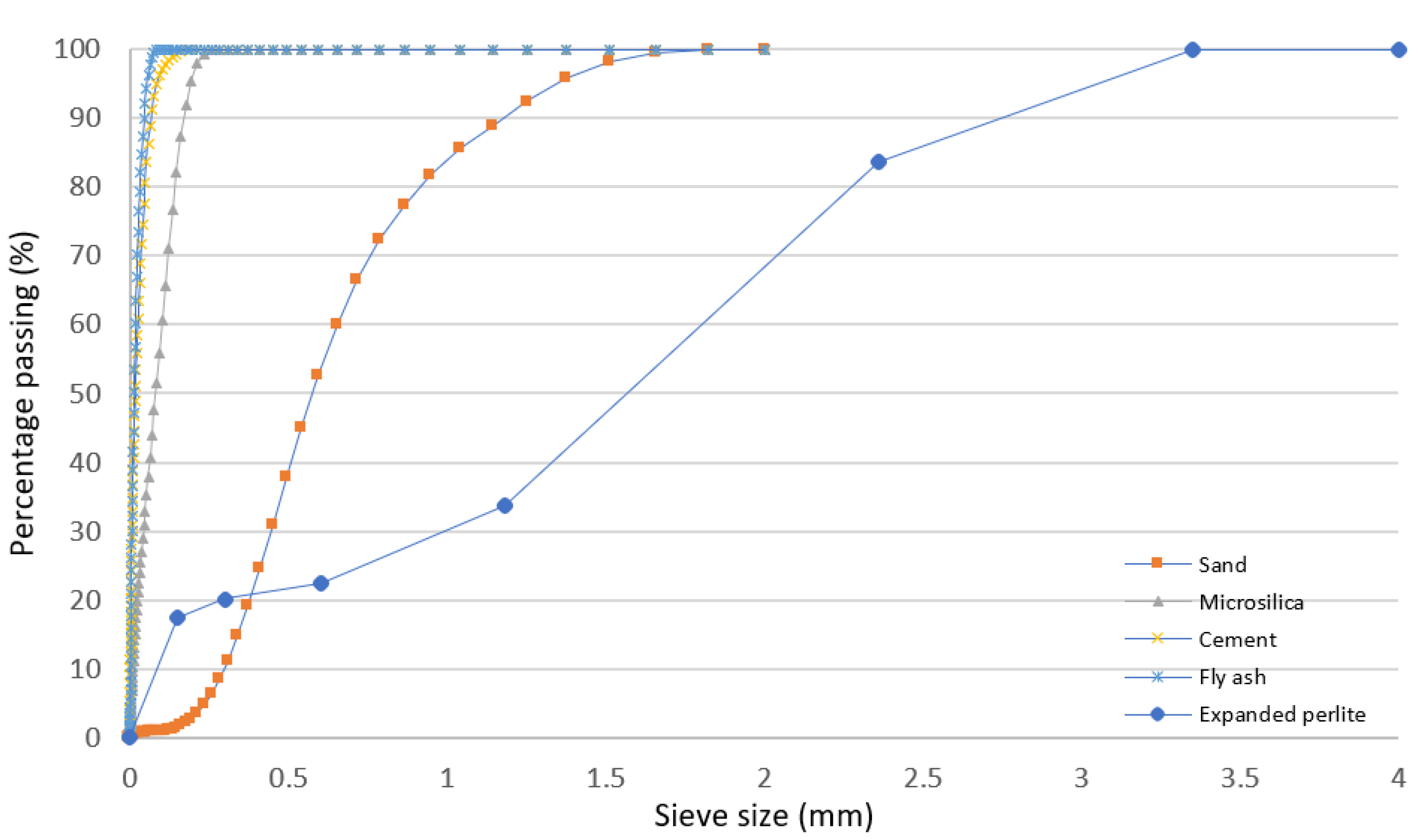
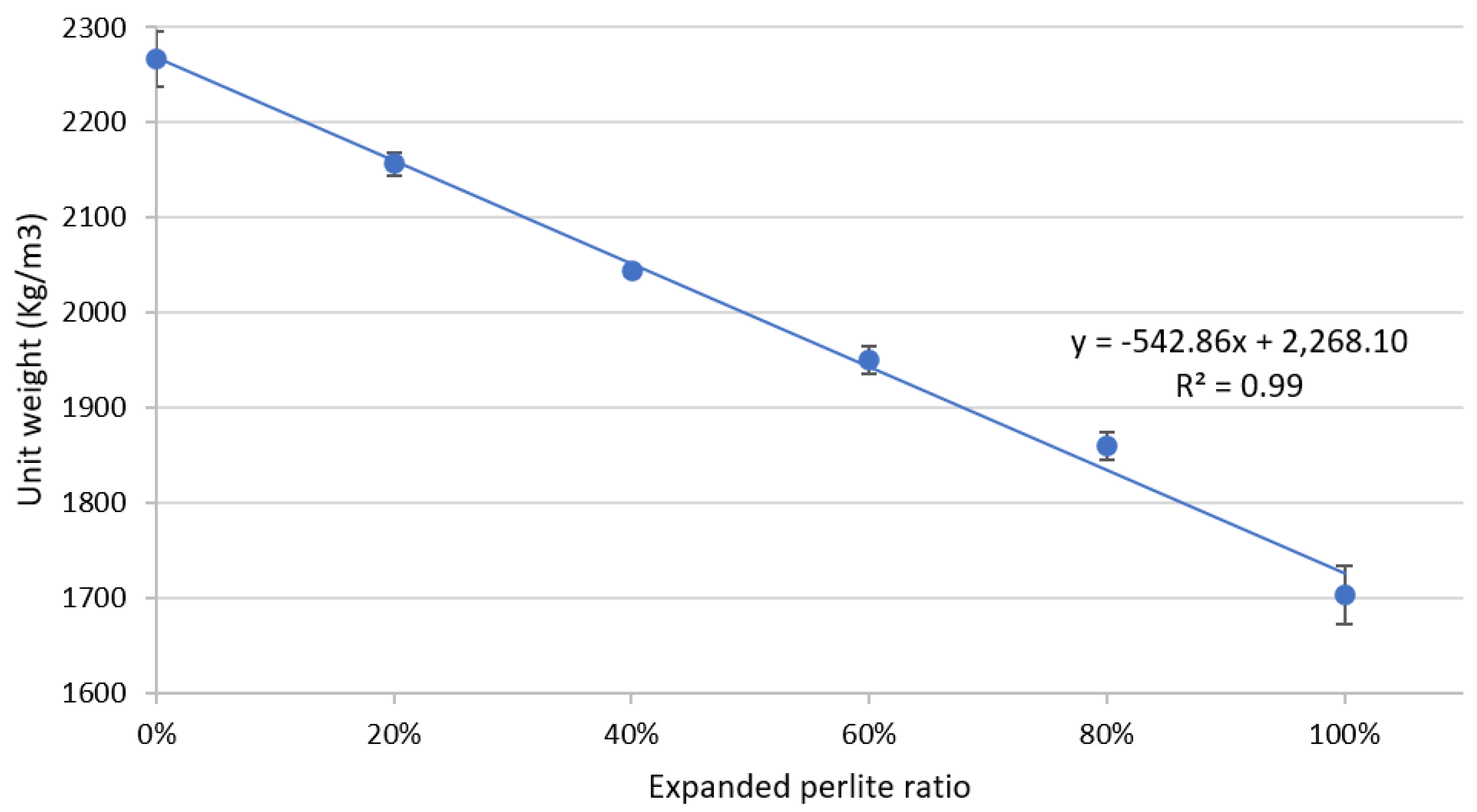
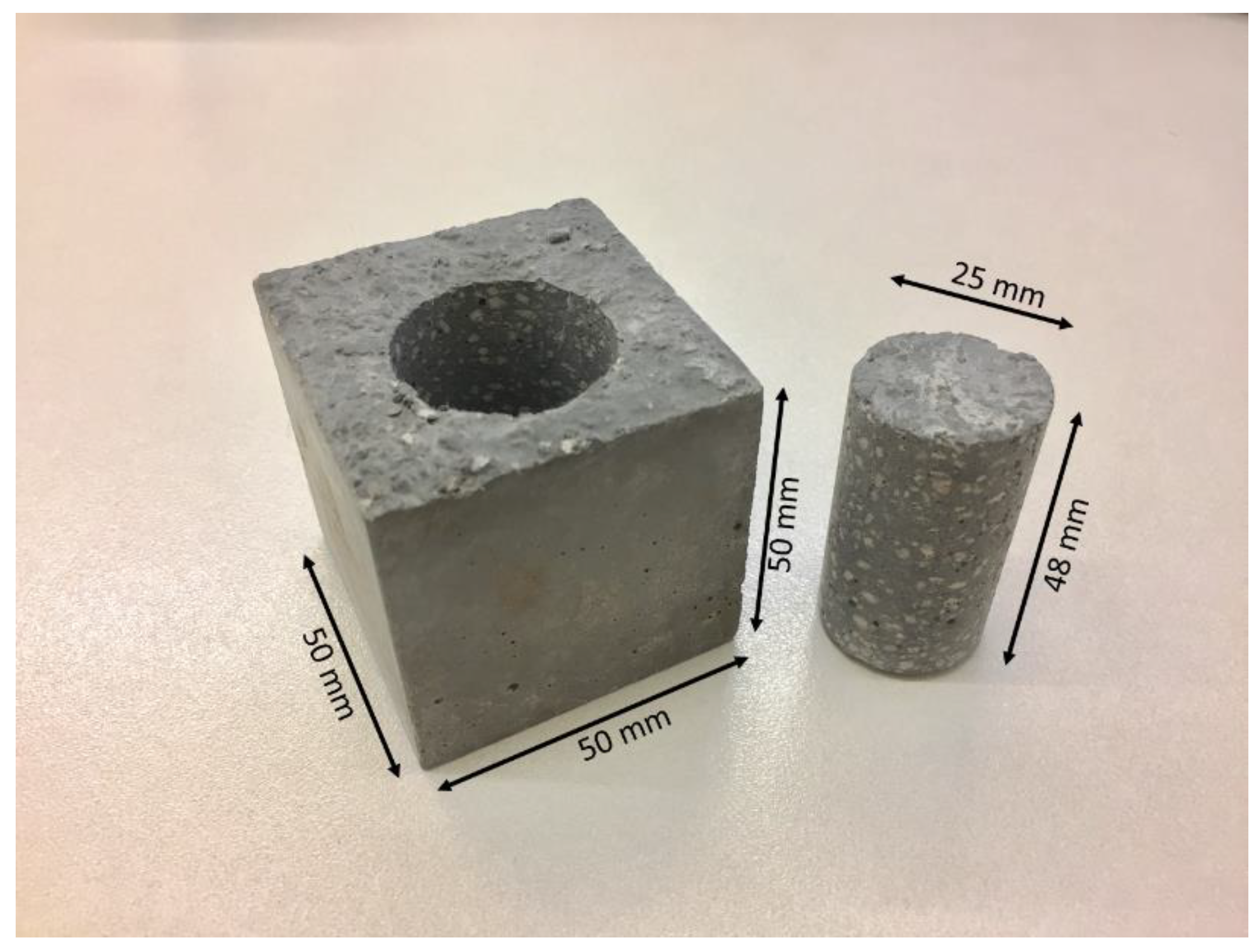
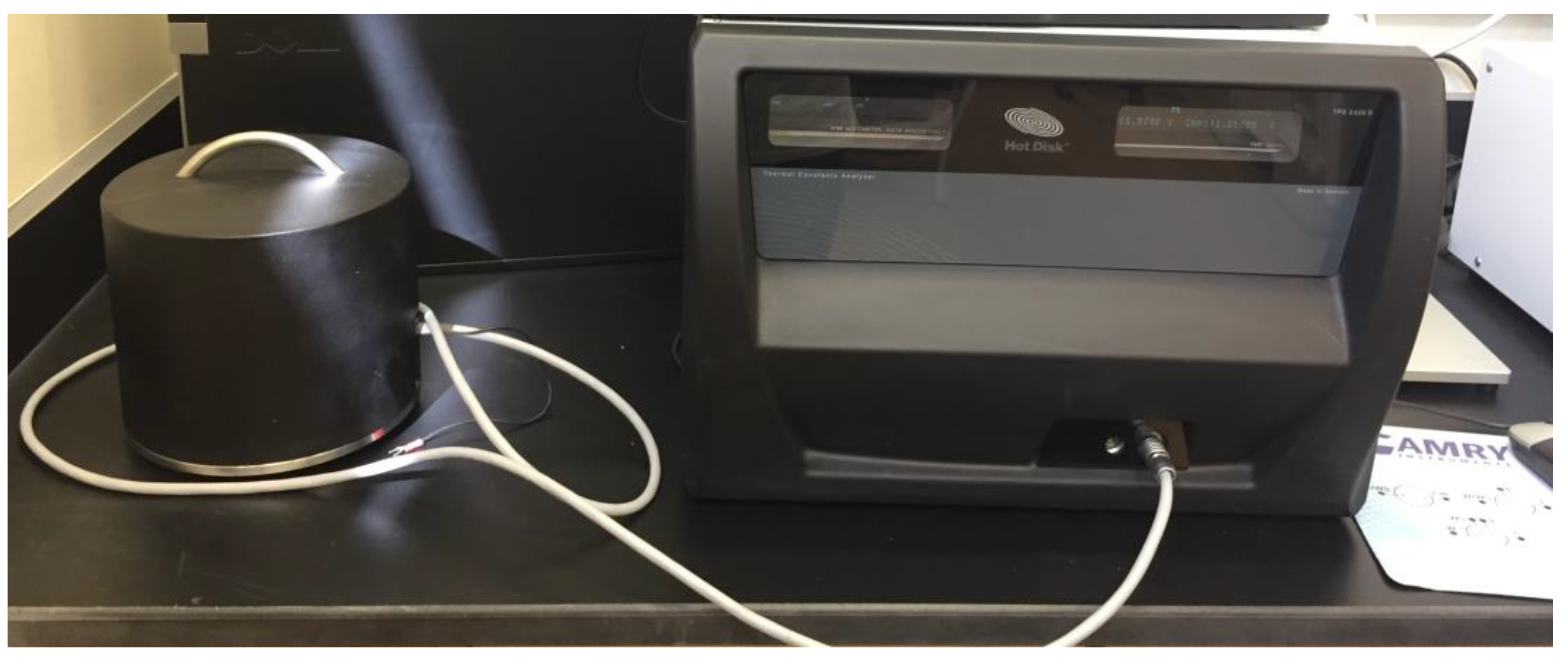


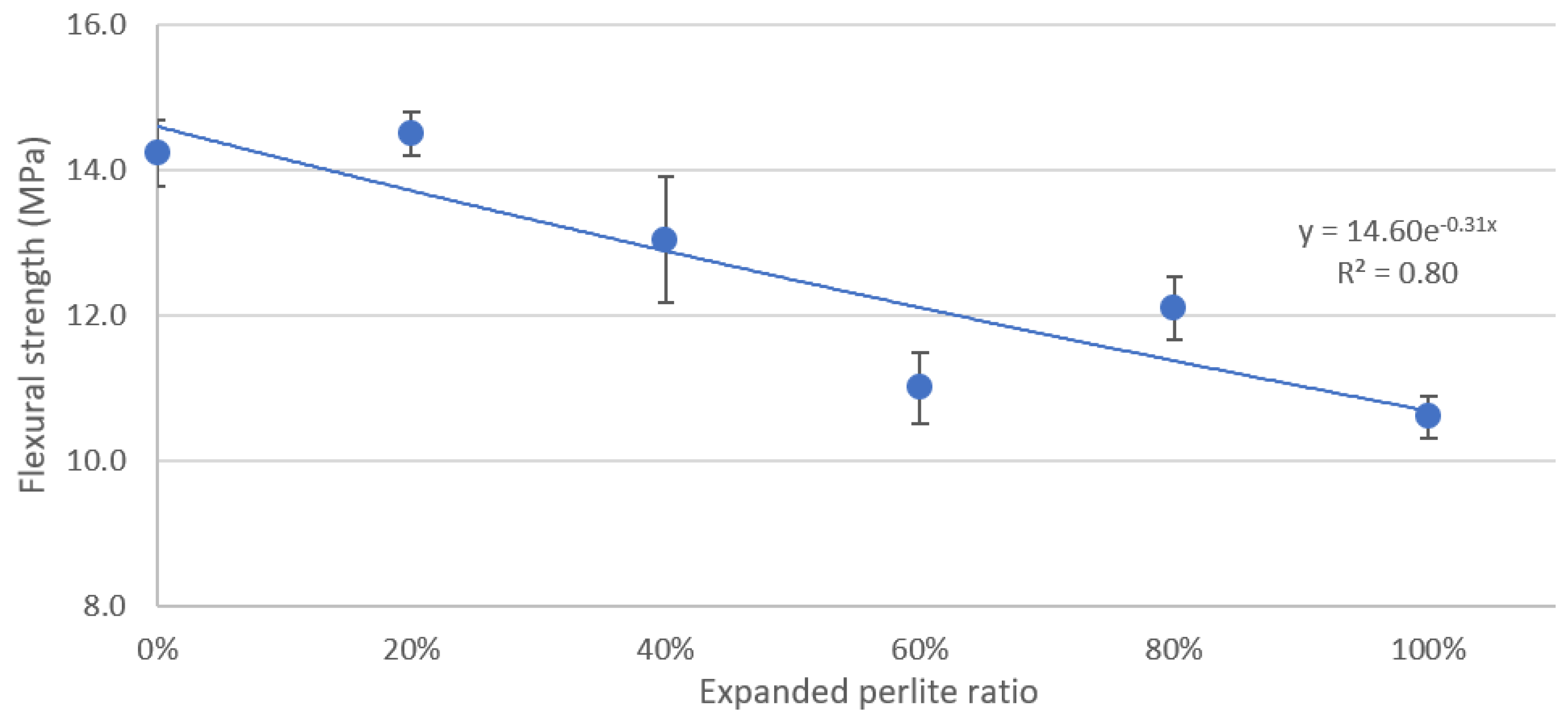
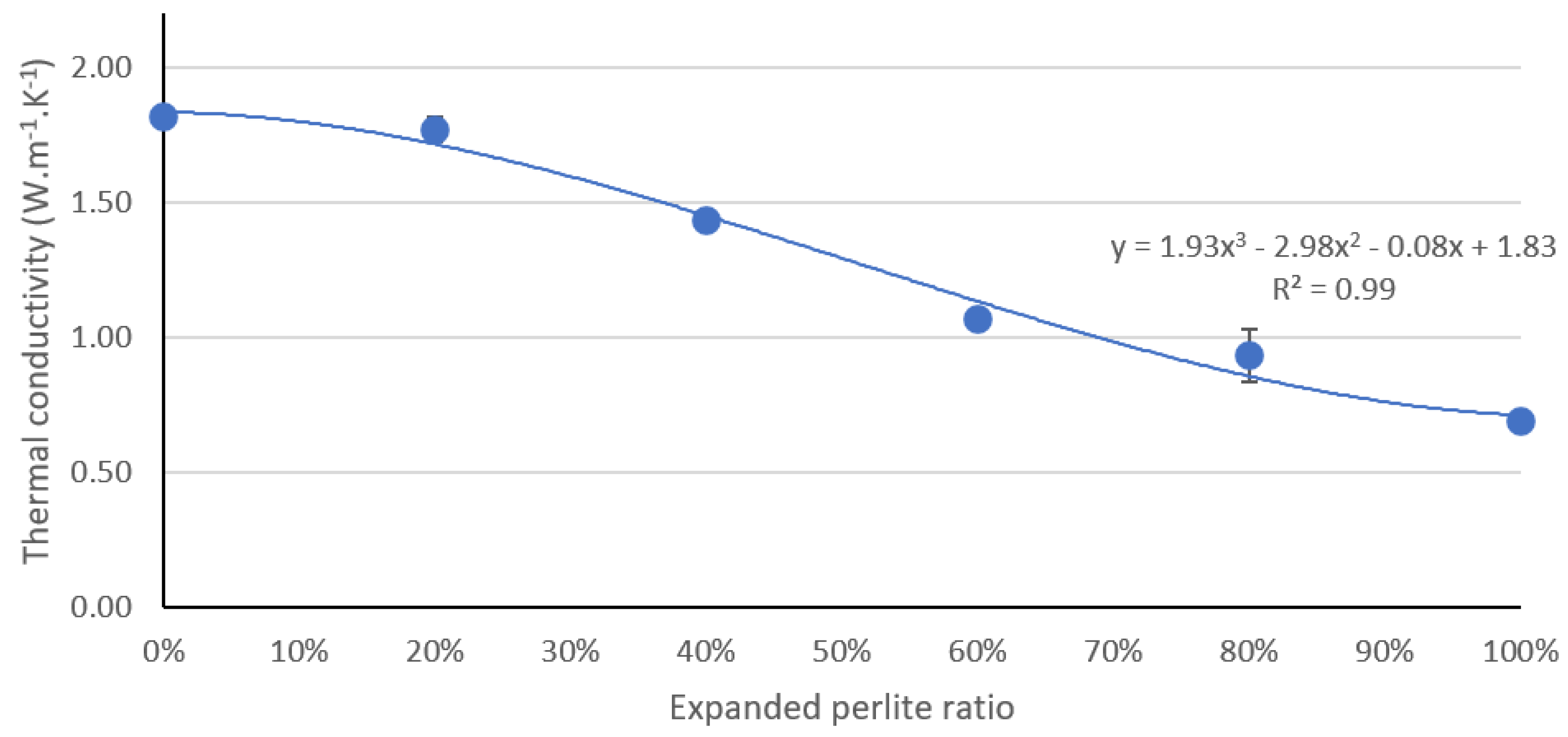
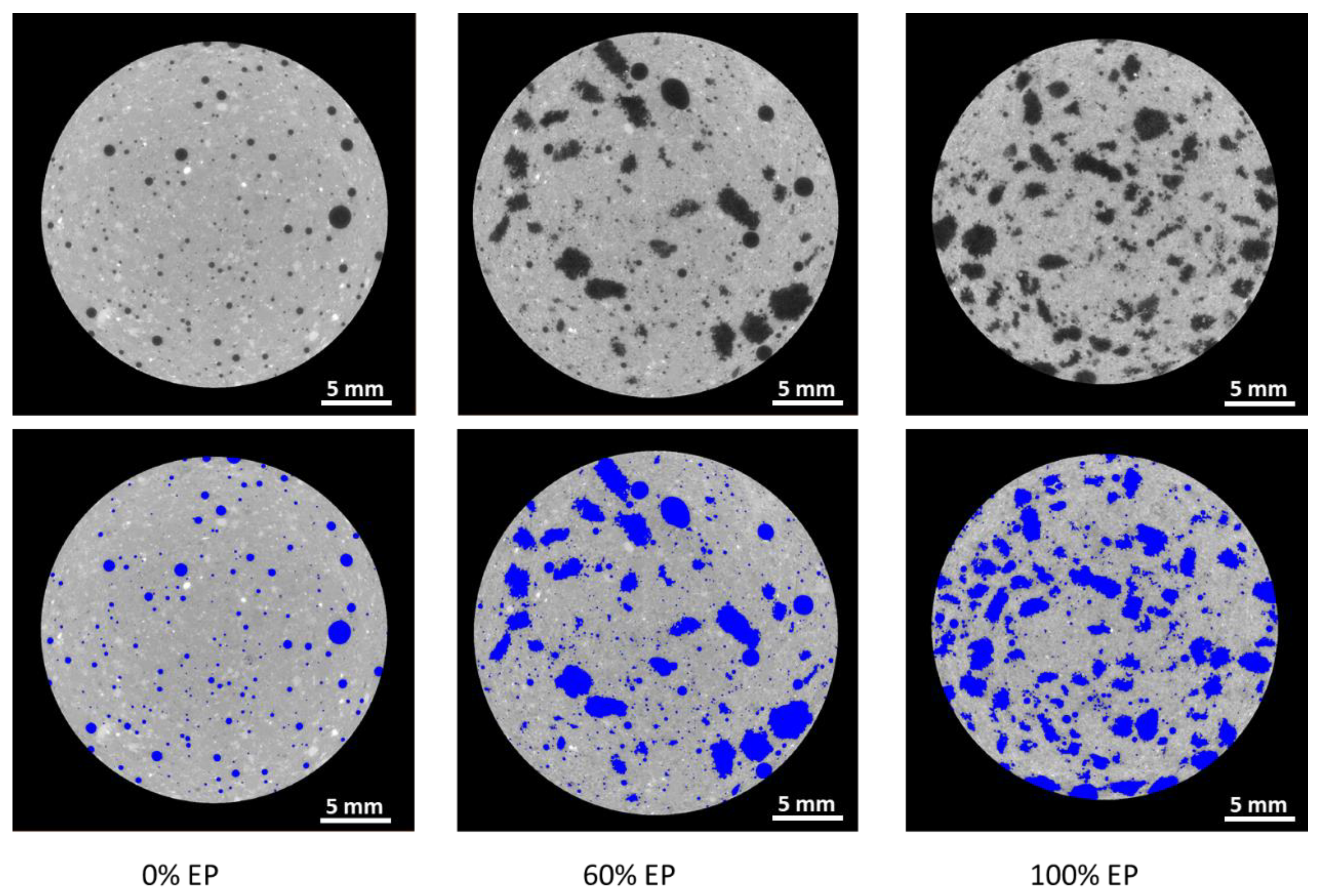
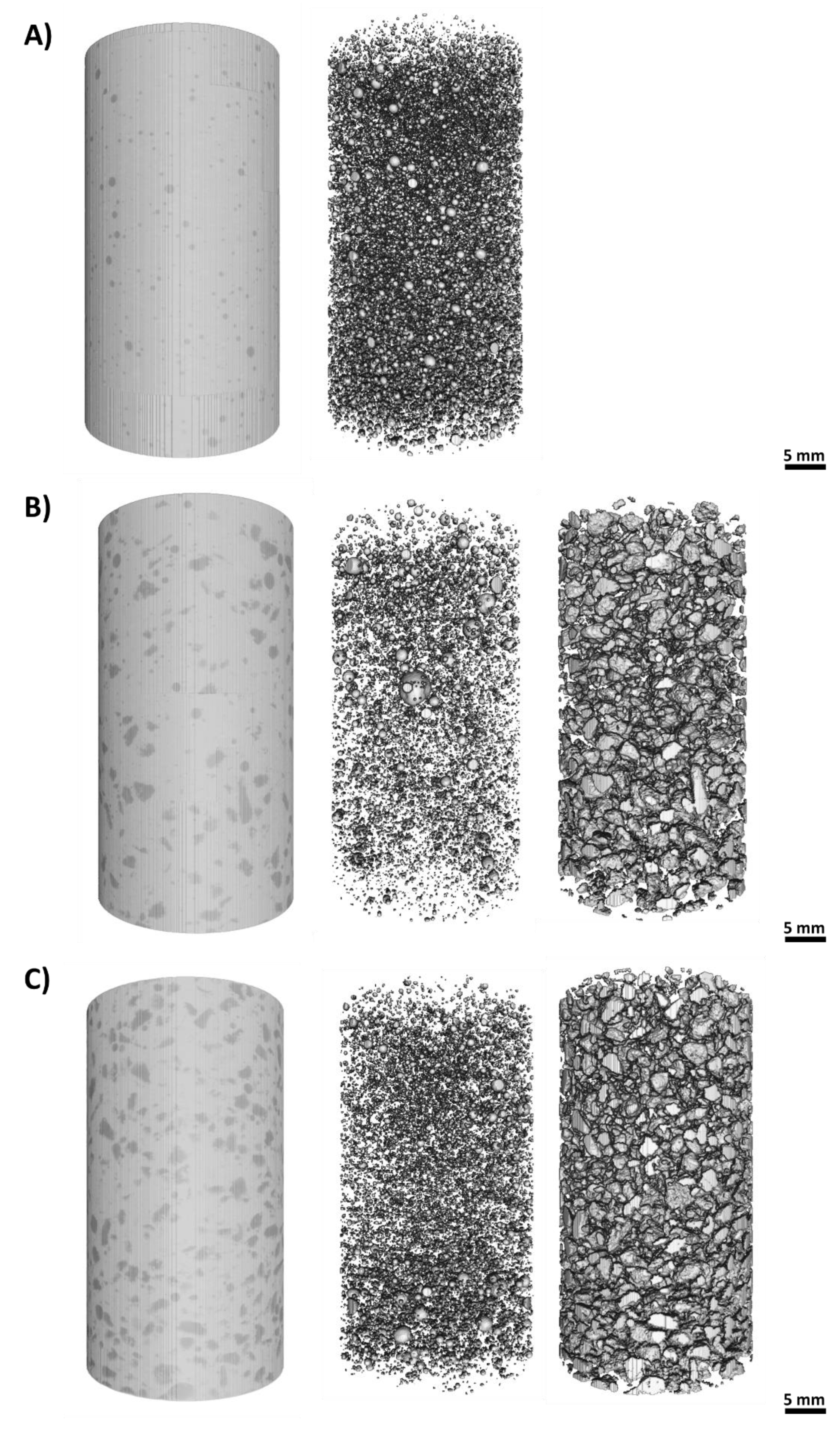



| Mixture Number | Mix 1 | Mix 2 | Mix 3 | Mix 4 | Mix 5 | Mix 6 |
|---|---|---|---|---|---|---|
| Expanded perlite percentage | 0% | 20% | 40% | 60% | 80% | 100% |
| River sand (kg/m3) | 1241 | 992.8 | 744.6 | 496.4 | 248.2 | 0.00 |
| Expanded perlite (kg/m3) | 0 | 12.77 | 25.55 | 38.32 | 51.09 | 63.86 |
| Cement (kg/m3) | 579 | 579 | 579 | 579 | 579 | 579 |
| Fly ash (kg/m3) | 165 | 165 | 165 | 165 | 165 | 165 |
| Microsilica (kg/m3) | 83 | 83 | 83 | 83 | 83 | 83 |
| Water (kg/m3) | 232 | 232 | 232 | 232 | 232 | 232 |
| Microfiber (kg/m3) | 1.2 | 1.2 | 1.2 | 1.2 | 1.2 | 1.2 |
| Superplasticizer (kg/m3) | 8.27 | 8.27 | 8.27 | 8.27 | 8.27 | 8.27 |
| Mixture Design | Mix 1: 0% EP | Mix 4: 60% EP | Mix 6: 100% EP | ||
|---|---|---|---|---|---|
| Particle type | Air Voids | Air Voids | EP | Air Voids | EP |
| Mean sphericity ( | 0.98 | 0.95 | 0.67 | 0.95 | 0.65 |
| Mean equivalent diameter (mm) | 0.39 | 0.23 | 0.73 | 0.24 | 0.76 |
| Mean 3D volume (mm3) | 0.07 | 0.03 | 0.56 | 0.02 | 0.57 |
| Volume fraction % | 1.45 | 1.15 | 7.78 | 1.07 | 9.99 |
© 2020 by the authors. Licensee MDPI, Basel, Switzerland. This article is an open access article distributed under the terms and conditions of the Creative Commons Attribution (CC BY) license (http://creativecommons.org/licenses/by/4.0/).
Share and Cite
Mohammad, M.; Masad, E.; Seers, T.; Al-Ghamdi, S.G. Properties and Microstructure Distribution of High-Performance Thermal Insulation Concrete. Materials 2020, 13, 2091. https://doi.org/10.3390/ma13092091
Mohammad M, Masad E, Seers T, Al-Ghamdi SG. Properties and Microstructure Distribution of High-Performance Thermal Insulation Concrete. Materials. 2020; 13(9):2091. https://doi.org/10.3390/ma13092091
Chicago/Turabian StyleMohammad, Malek, Eyad Masad, Thomas Seers, and Sami G. Al-Ghamdi. 2020. "Properties and Microstructure Distribution of High-Performance Thermal Insulation Concrete" Materials 13, no. 9: 2091. https://doi.org/10.3390/ma13092091
APA StyleMohammad, M., Masad, E., Seers, T., & Al-Ghamdi, S. G. (2020). Properties and Microstructure Distribution of High-Performance Thermal Insulation Concrete. Materials, 13(9), 2091. https://doi.org/10.3390/ma13092091






